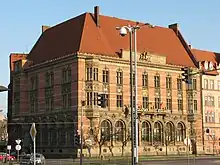
The Bank of Danzig (German: Bank von Danzig) was the central bank of the Free City of Danzig, established in 1924 and liquidated in the aftermath of the Danzig crisis in 1939.
Overview

The Bank of Danzig was created under the conditions of the stabilization loan coordinated by the Economic and Financial Organization of the League of Nations in 1923–1024, based on the successful precedent of Austria a year earlier. It was established on 5 February 1924 with a capital of 7.5 million guilders, after the Reichsbank had ceased operations in the Free City on 31 December 1923. Its investors were private businesspeople and companies, including a consortium of Polish banks.[1]: 516 It soon started operations on 17 March 1924. It issued the Danzig gulden, which replaced the Reichsmark which had been devalued by hyperinflation.
The bank's first Governor was Konrad Meissner, then Walter Bredow, then Carl-Anton Schaefer from 1933.[2]: 176 The chairman of the supervisory board was Carl William Klawitter, and after the latter's death in 1929, Ernst Plagemann.
After the annexation of Danzig by the German Reich, the Reichsmark was introduced in Danzig and the Bank of Danzig was liquidated. The bank's gold holdings, which served as currency cover, were mainly stored at the Bank of England in London. With the Nazi invasion of Poland, these assets were confiscated by the British government and in 1976 handed over to Poland, which had annexed Danzig in 1945.[3] The bank's building again served as a branch of the Reichsbank from 1939 to 1945, when it was badly damaged by wartime bombing. After 1945 it has been used by the National Bank of Poland.
See also
Notes
- ↑ Margaret G. Myers (December 1945), "The League Loans", Political Science Quarterly, 60 (4): 492–526, doi:10.2307/2144667, JSTOR 2144667
- ↑ Carl Jacob Burckhardt (1960), My Danzig Mission 1937-1939, Munich: Callwey
- ↑ "Danziger Gold". Der Spiegel. 29 August 1976.